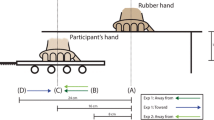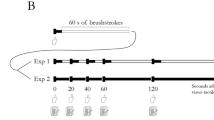Abstract
The rubber hand illusion is an experimental paradigm in which participants consider a fake hand to be part of their body. This paradigm has been used in many domains of psychology (i.e., research on pain, body ownership, agency) and is of clinical importance. The classic rubber hand paradigm nevertheless suffers from limitations, such as the absence of active motion or the reliance on approximate measurements, which makes strict experimental conditions difficult to obtain. Here, we report on the development of a novel technology—a robotic, user- and computer-controllable hand—that addresses many of the limitations associated with the classic rubber hand paradigm. Because participants can actively control the robotic hand, the device affords higher realism and authenticity. Our robotic hand has a comparatively low cost and opens up novel and innovative methods. In order to validate the robotic hand, we have carried out three experiments. The first two studies were based on previous research using the rubber hand, while the third was specific to the robotic hand. We measured both sense of agency and ownership. Overall, results show that participants experienced a “robotic hand illusion” in the baseline conditions. Furthermore, we also replicated previous results about agency and ownership.





Similar content being viewed by others
References
Aldhous, P. (2009). Illusion could give prosthetics a sense of touch. New Scientist, 201(2692), 15.
Allison, B. Z., Wolpaw, E. W., & Wolpaw, J. R. (2007). Brain computer interface systems: Progress and prospects. British Review of Medical Devices, 4(4), 463–474.
Armel, K. C., & Ramachandran, V. S. (2003). Projecting sensations to external objects: Evidence from skin conductance response. Proceedings of the Royal Society of London: Biological, 270, 1499–1506.
Aspell, J., Lenggenhager, B., & Blanke, O. (2009). Keeping in touch with one’s self: Multisensory mechanisms of self-consciousness. PLoS ONE, 4, e6488. doi:10.1371/journal.pone.0006488
Barber, T. X., & Silver, M. J. (1968). Fact, fiction, and the experimenter bias effect. Psychological Bulletin, 70, 1–29. doi:10.1037/h0026724
Barnsley, N., McAuley, J., Mohan, R., Dey, A., Thomas, P., & Moseley, G. (2011). The rubber hand illusion increases histamine reactivity in the real arm. Current Biology, 21(23), R945–R946.
Beckerle, P., Christ, O., Wojtusch, J., Schuy, J., Wolff, K., Rinderknecht, S. .… & von Stryk, O. (2012). Design and control of a robot for the assessment of psychological factors in prosthetic development. Systems, Man, and Cybernetics (SMC), 2012 IEEE International Conference on IEEE, pp. 1485–1490.
Bicchi, A. (2000). Hand for dexterous manipulation and robust grasping: A difficult road toward simplicity. IEEE Transactions on Robotics and Automation, 16(6), 652–662.
Botvinick, M., & Cohen, J. (1998). Rubber hands ‘feel’ touch that eyes see. Nature, 391, 756.
Costantini, M., & Haggard, P. (2007). The rubber hand illusion: Sensitivity and reference frame for body ownership. Consciousness and Cognition, 16(2), 229–240.
Cherelle, P., Grosu, V., Matthys, A., Vanderborght, B., & Lefeber, D. (2013). Design and validation of the ankle mimicking prosthetic (amp-) foot 2.0. IEEE Transactions on Neural Systems and Rehabilitation Engineering.
Christ, O., Wojtusch, J., Beckerle, P., Wolff, K., Vogt, J., von Stryk, O., & Rinderknecht, S. (2012). Prosthesis-user-in-the-loop: User-centered design parameters and visual simulation. Engineering in Medicine and Biology Society (EMBC), Annual International Conference of the IEEE. IEEE, 2012, pp. 1929–1932.
Davis, S., Tsagarakis, N.G. & Caldwell, D.G. (2008). The initial design and manufacturing process of a low cost hand for the robot iCub. IEEE-RAS International Conference on Humanoid Robots.
Doyen, S., Klein, O., Pichon, C., & Cleeremans, A. (2012). Behavioral priming: It is all in the brain, but whose brain? PLoS ONE, 7(1), e29081. doi:10.1371/journal.pone.0029081
Dummer, Picot-Annand, Neal, & Moore. (2009). Movement and the rubber hand illusion. Perception, 38, 271–280.
Ehrsson, H. H., Spence, C., & Passingham, R. E. (2004). ‘That’s my hand!’ Activity in the premotor cortex reflects feeling of ownership of a limb. Science, 305, 875–877.
Ehrsson, H., Rosén, B., Stockselius, A., Ragnö, C., Köhler, P., & Lundborg, G. (2008). Upper limb amputees can be induced to experience a rubber hand as their own. Brain, 131, 2443–3452.
Gallagher, S. (2000). Philosophical conceptions of the self: Implications for cognitive science. Trends in Cognitive Sciences, 4(1), 14–21.
Geeroms J, Flynn L, Jimenez-Fabian R, Vanderborght B, Lefeber D. (2013) Ankle-Knee prosthesis with powered ankle and energy transfer for CYBERLEGs α-prototype. IEEE International Conference on Rehabilitation Robotics :6650352. doi: 10.1109/ICORR.2013.6650352
Graziano, M. S., Cooke, D. F., & Taylor, C. S. (2000). Coding the location of the arm by sight. Science, 290, 1782–1786.
Grebenstein, M., Albu-Schaffer, A., Bahls, T., Chalon, M., Eiberger, O., Friedl, W., … & Hirzinger, G. (2011). The DLR hand arm system. Robotics and Automation (ICRA), IEEE International Conference, pp. 3175–3182.
Guterstam, A., Gentile, G., & Erhsson, H. H. (2013). The invisible hand illusion: Multisensory Integration leads to the embodiment of a discrete volume of empty space. Journal of Cognitive Neuroscience, 25(7), 1078–1099.
Haans, A., IJsselsteijn, W. A., & de Kort, Y. A. W. (2008). The effect of similarities in skin texture and hand shape on perceived ownership of a fake limb. Body Image: An International Journal of Research, 5, 389–394.
Haggard, P., Clark, S., & Kalogeras, J. (2002). Voluntary action and conscious awareness. Nature Neuroscience, 5(4), 382–385. doi:10.1038/nn827
Haselager, P. (2013). Did I do that? Brain–computer interfacing and the sense of agency. Minds and Machines, 23(3), 405–418.
Holle, H., McLatchie, N., Maurer, S., & Ward, J. (2011). Proprioceptive drift without illusions of ownership for rotated hands in the ‘rubber hand illusion’ paradigm. Cognitive Neuroscience, 3, 1–8.
Ionta, S., Sforza, A., Funato, M., & Blanke, O. (2013). Anatomically plausible illusory posture affects mental rotation of body parts’. Cognitive, Affective, & Behavioral Neuroscience, 13(1), 197–209.
Kalckert, A., & Ehrsson, H. H. (2012). Moving a rubber hand that feels like your own: A dissociation of ownership and agency. Frontiers in Human Neuroscience, 6, 1–14.
Kuznetsov, S., & Paulos, E. (2010). Rise of the expert amateur: DIY projects, communities, and cultures. Proceedings of the 6th Nordic Conference on Human-Computer Interaction: Extending Boundaries, pp. 295–304.
Hochberg, L.R., Bacher, D., Jarosiewicz, B., Masse, N.Y., Simeral, J.D., Vogel, J., … & Donoghue, J.P. (2012). Reach and grasp by people with tetraplegia using a neurally controlled robotic arm. Nature, 485, 372–375.
Lloyd, D. M. (2007). Spatial limits on referred touch to an alien limb may reflect boundaries of visuo- tactile peripersonal space surrounding the hand. Brain & Cognition, 64, 104–109.
Longo, M. R., Schüür, F., Kammers, M. P. M., Tsakiris, M., & Haggard, P. (2008). What is embodiment? A psychometric approach. Cognition, 107, 978–998.
Makin, T. R., Holmes, N. P., & Zohary, E. (2007). Is that near my hand? Multisensory representation of peripersonal space in human intraparietal sulcus. Journal of Neuroscience, 27, 731–740.
Makin, T. R., Holmes, N. P., & Ehrsson, H. H. (2008). On the other hand: Dummy hands and peripersonal space. Behavioural Brain Research, 191, 1–10.
Melchiorri, C., Palli, G., Berselli, G., & Vassura, G. (2013). Development of the UB Hand IV. IEEE Robotics & Automation Magazine 1070, no. 9932/13.
Moseley, G. L., Olthof, N., Venema, A., Don, S., Wijers, M., Gallace, A., & Spence, C. (2008). Psychologically induced cooling of a specific body part caused by the illusory ownership of an artificial counterpart. Proceedings of the National Academy of Sciences of the United States of America, 105, 13169–13173. doi:10.1073/pnas.0803768105
Pratichizzo, D., Malvezzi, M. & Bicchi, A. (2010). On motion and force controllability of grasping hands with postural synergies. Proceedings of Robotics: Science and Systems.
Ramakonar, H., Franz, E. A., & Lind, C. R. P. (2011). The rubber hand illusion and its application to clinical neuroscience. Journal of Clinical Neuroscience, 18(2), 1596–1601.
Riemer, M., Kleinböhl, D., Hölzl, R., & Trojan, J. (2013). Action and perception in the rubber hand illusion. Experimental Brain Research, 229(3), 383–393.
Rohde, M., Di Luca, M., & Ernst, M. O. (2011). The rubber hand illusion: Feeling of ownership and proprioceptive drift do not go hand in hand. PLoS ONE, 6(6), e21659.
Roessler, J., & Eilan, N. (Eds.). (2003). Agency and self-awareness. Oxford: Oxford University Press.
Rosenthal, R., & Lawson, R. (1964). A longitudinal study of the effects of experimenter bias on the operant learning laboratory rats. Journal of Psychiatric Research, 2(2), 61–71.
Rosenthal, R., Gordon, W. P., & Kermit, L. F. (1962). Experimenter bias, anxiety, and social desirability. Perceptual and Motor Skill, 15(1), 73–74.
Shimada, S., Fukuda, K., & Hiraki, K. (2009). Rubber hand illusion under delayed visual feedback. PLoS ONE, 4(7), e6185. doi:10.1371/journal.pone.0006185
Townsend, W. (2000). Barrett hand grasper. Journal of Industrial Robots, 27(3), 181–188.
Troffer, S. A., & Tart, C. T. (1964). Experimenter bias in hypnotist performance. Science, 145, 1330–1331. doi:10.1126/science.145.3638.1330
Tsakiris, M., & Haggard, P. (2003). Awareness of somatic events associated with a voluntary action. Experimental Brain Research, 149, 439–446.
Tsakiris, M., Haggard, P., Franck, N., Mainy, N., & Sirigu, A. (2005a). A specific role for efferent information in self-recognition. Cognition, 96(3), 215–231.
Tsakiris, M., Prabhu, G., & Haggard, P. (2005b). Having a body versus moving your body: How agency structures body-ownership. Consciousness and Cognition, 15(2), 423–432.
Tsakiris, M., & Haggard, P. (2005). The rubber hand illusion revisited: Visuotactile integration and self- attribution. Journal of Experimental Psychology: Human Perception and Performance, 31(1), 80–91.
Tsakiris, M., Prabhu, G., & Haggard, P. (2006). Having a body versus moving your body: How agency structures body-ownership. Consciousness & Cognition, 15(2), 423–432.
Tsakiris, M., Hesse, M., Boy, C., Haggard, P., & Fink, G. R. (2007a). Neural correlates of body-ownership: A sensory network for bodily self-consciousness. Cerebral Cortex, 17, 2235–2244.
Tsakiris, M., Schütz-Bosbach, S., & Gallagher, S. (2007b). On agency and body-ownership: Phenomenological and neurocognitive reflections. Consciousness & Cognition, 16(3), 645–660.
Tsakiris, M. (2010). My body in the brain: A neurocognitive model of body-ownership. Neuropsychologia, 48, 703–712.
Tsakiris, M., Longo, M. R., & Haggard, P. (2010). Having a body versus moving your body: Neural signatures of agency and body-ownership. Neuropsychologia, 48(9), 2740–2749. doi:10.1016/j.neuropsychologia.2010.05.021
Tsakiris, M., Tajadura-Jiménez, A., & Costantini, M. (2011). Just a heartbeat away from one’s body: Interoceptive sensitivity predicts malleability of body-representations. Proceedings of the Royal Society B: Biological Science, 278(1717), 2470–2476. doi:10.1098/rspb.2010.2547
Tuffield, P., & Elias, H. (2003). The shadow robot mimics human actions. Industrial Robot: An International Journal, 30(1), 56–60.
van den Bos, E., & Jeannerod, M. (2002). Sense of body and sense of action both contribute to self-recognition. Cognition, 85, 177–187.
Yoshibawa, T. (2010). Multifingered robot hands: Control for grasping and manipulation. Annual Reviews in Control, 34(2), 199–208.
Zopf, R., Savage, G., & Williams, M. A. (2010). Crossmodal congruency measures of lateral distance effects on the rubber hand illusion. Neuropsychologia, 48, 713–725. doi:10.1016/j.neuropsychologia.2009.10.028
Acknowledgments
This work was funded by the FRS-F.N.R.S. (Fonds de la Recherche Scientifique) and by Grant P7/33 from the Belgian Science Policy Office (Interuniversity Poles of Attraction Program). The funders had no role in study design, data collection and analysis, decision to publish, or preparation of the manuscript. We thank the editor and the two anonymous reviewers for commenting on earlier versions of the manuscript. We also thank Jéromy Hrabovecky for his help in the proof of the manual.
Author information
Authors and Affiliations
Corresponding author
Electronic supplementary material
Rights and permissions
About this article
Cite this article
Caspar, E.A., De Beir, A., Magalhaes De Saldanha Da Gama, P.A. et al. New frontiers in the rubber hand experiment: when a robotic hand becomes one’s own. Behav Res 47, 744–755 (2015). https://doi.org/10.3758/s13428-014-0498-3
Published:
Issue Date:
DOI: https://doi.org/10.3758/s13428-014-0498-3




